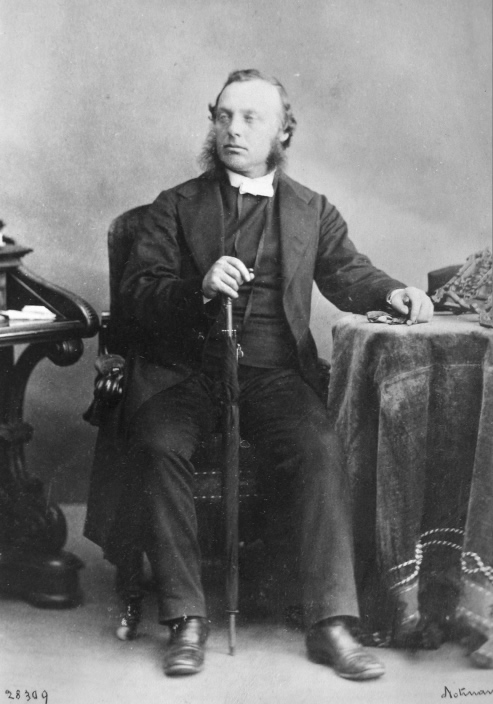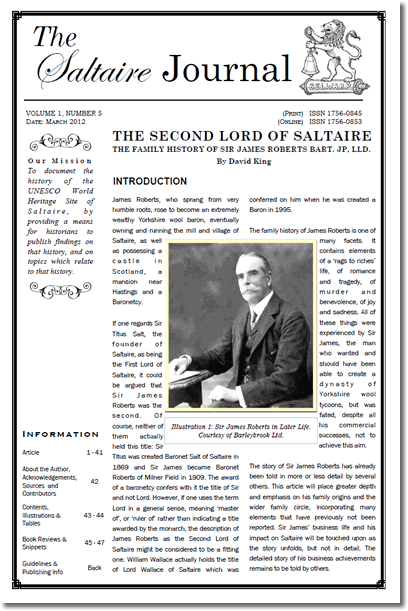Who was your grandmother, Titus, and when did you arrive in Bradford?
More research by David King >
 David King writes: Anyone who has read the biography of Sir Titus Salt, written and published by the Rev Balgarnie in 1877, within one year of the death of Sir Titus, will have read answers to these questions.
David King writes: Anyone who has read the biography of Sir Titus Salt, written and published by the Rev Balgarnie in 1877, within one year of the death of Sir Titus, will have read answers to these questions.
Balgarnie states that the bulk of the information found in the biography is ‘drawn from our own personal knowledge of the late Baronet, which an intimate and unbroken friendship of many years supplies.’ So Balgarnie was well equipped to know the true facts about Sir Titus’ life.

Robert Balgarnie
[The text of Balgarnie's biography of Sir Titus Salt is free to download from this website.]
In answer to the first question Balgarnie tells us that Salt’s grandfather, also called Titus, and of Sheffield, married Sarah Taylor, a widow, in 1763. He adds that the grandfather died in 1804 and the grandmother in 1802, ‘both well stricken in years and were buried in Hunslet churchyard. He then goes on to say, ‘These were the grandparents of the late Baronet.’
Regarding the second question, the biography relates that ‘In the year 1822 Titus Salt came with his parents to Bradford, he being then about nineteen years of age.’ So why have the two questions been posed? Surely the answers are clearly supplied in the biography?
But let us look more closely at the life of Sir Titus Salt’s grandfather. We have been told that he had married Sarah Taylor in 1763. From baptismal records it can be seen that the couple were childless until the birth of a son, Titus, in 1775. There then followed a daughter, Elizabeth, in 1777 and a son Daniel, the father of Sir Titus, in 1781 – childless for twelve years, then three children within the space of six years. Surely this is a rather unusual state of affairs and requires further investigation?
Who was Sir Titus Salt's paternal grandmother?
Looking at church records once again, the marriage of Titus Salt to Sarah Taylor, widow, can indeed be found, having taken place at the Church of St Peter and St Paul, Sheffield (now Sheffield Cathedral) on 21 April 1763. Looking more closely, however, the marital status of Titus is given as ‘widower’. So Sarah Taylor was not his first wife. The records also show that Sarah Taylor died in 1769 in Sheffield and not in 1802 in Hunslet as stated by Balgarnie.
Further investigation of the church records reveals that Titus had married as his first wife a Rachel Wyatt at the Church of St Peter and St Paul, Sheffield, on 18 April 1751. Rachel, his first wife, had also met with an early death which occurred in 1762, in Sheffield.
Balgarnie’s biography also relates that Titus had moved from Sheffield to Hunslet, Leeds, and he was buried there in 1804, as mentioned earlier. When he moved to Hunslet, Titus would have been a widower, his first two wives having died whilst he was living in Sheffield. It is here that Titus is found marrying for a third time. On this occasion it was to Sarah Howit at Leeds Parish Church on 11 May 1774.
As previously mentioned, Titus’ first child was born in 1775, so this child was born to Sarah Howit and not to Sarah Taylor, Therefore, Sarah Howit and not Sarah Taylor was the grandmother of Sir Titus.
The death of Titus’ second wife, Sarah Taylor and his subsequent remarriage to Sarah Howit explains the time lapse between his marriage to Sarah Taylor and the birth of his first child, followed by the arrival of two more children in rapid succession.
All biographers and commentators on the life of Sir Titus Salt, subsequent to the publication of Balgarnie’s biography, have erroneously stated that Titus Salt’s grandmother was Sarah Taylor, relying on the account given by Balgarnie. In fact the grandfather of Sir Titus had married three times and his children were the result of his third marriage.
At her death, in 1802, Sarah Howit, who was buried at Hunslet, was approximately 58 years of age, so scarcely ‘well stricken in years’, as stated by Balgarnie, even allowing for the shorter life spans to be expected in those times.
When did Sir Titus Salt actually relocate to Bradford?
Moving on to the next question, which concerns the date when the young Titus Salt arrived in Bradford, the Rev Balgarnie once more supplies an answer. In the biography he says, ‘In the year 1822 Titus Salt came with his parents to Bradford, he being then about nineteen years of age.’
However, once again the facts do not support this statement. Hannah Salt, the youngest child of Daniel Salt, Sir Titus’ father, and sister to Sir Titus, was baptised at Horton Lane Congregational Chapel on 27 June 1821, having been born on 14 October 1820. The abode of the parents is given as ‘Bradford’. So the Salts were in Bradford by June 1821 at the latest.
Turning to Baines’ ‘History and Gazetteer of The County of York’, the dedication to which is dated by the author as 1 January 1822, Daniel Salt is listed as a woolstapler in Market Street, Bradford. The data in the Gazetteer must have taken at least a whole year, probably more, to assemble and print, so it is possible that Titus Salt arrived with his parents in Bradford as early as 1820.
Once again, all historians and commentators on the life of Sir Titus, subsequent to the biography by the Rev Balgarnie, have repeated his statement that Titus arrived in Bradford in 1822.
In conclusion, it can be seen that Balgarnie was incorrect on two important facts concerning Titus Salt, errors which have been repeated for more than 140 years
The question must be asked whether Sir Titus himself was fully aware of the details of his grandmother, who had died before he was born, and of his arrival in Bradford. Or could it be that Balgarnie obtained some of his information from unreliable third parties after the death of Sir Titus?
The question must also be raised as to how many more incorrect statements may have been made by the Rev Balgarnie in his biography of Salt. Perhaps more errors will come to light in due course.
A postscript regarding the birth year of Sir Titus Salt’s grandfather, Titus Salt.
Over the years several family trees of the Salts have been published which have given the year 1725 as the birth year of Sir Titus Salt’s grandfather, without revealing the source of this information.
To date it has not been possible to trace the baptism of Salt’s grandfather in any of the parish records available on-line. However, each of the marriages of Titus Salt’s grandfather was carried out by special licence and not by the reading of banns as is more usual. On the special licence each party to the marriage is required to declare their age at the time of the marriage.
At the marriage of Titus and Rachel Wyatt in April 1751 Titus states his age to be 25, giving a birth year of 1725/26 and that of his spouse as 37, giving a birth year of 1713/14.
At the marriage of Titus and Sarah Taylor in April 1763 Titus’ age is declared to be 39, giving a birth year of 1723/24 and that of his spouse as 40, giving a birth year of 1722/23.
At the marriage of Titus and Sarah Howit in May 1774 the age of Titus is stated to be 35, giving a birth year of 1738/39 and that of Sarah as 30, giving a birth year of 1743/44.
So there is no consistency in the dates of birth given for Titus. At the first two marriages there is partial consistency, giving a birth year of between 1723 and 1726. However, at the third marriage Titus has become between 13 and 15 years younger. Perhaps this was owing to the fact that Sarah Howit was only 35 at their marriage and Titus did not wish to reveal that he could actually have been around 50 years of age.
Considering the age given at the third marriage to be completely fictitious, it is likely the Titus Salt’s grandfather was actually born between the years 1723 and 1726, which is in line with the date of 1725 that has been quoted in published family trees. However, at present, there is no infallible documentary evidence to confirm this.
David King, May 2020
More research by David King
Volume 1, Number 4 Published March 2010
 The Whitlams?... Who Are They?
The Whitlams?... Who Are They?
By David King
Read this Saltaire Journal >
(Acrobat file: Size 16.7 MB)
It is well known that Caroline Whitlam
of Grimsby married Titus Salt at
Grimsby Parish Church on 21st
August, 1830. When Titus Salt
received his baronetcy she became
Lady Salt (see Illustration 1). The
couple had 11 children and Caroline
outlived Sir Titus
by over 16 years, residing in
London in her
later life. She
died in 1893 at
St Leonard’s on
Sea, aged 81.
Much has been
written about the
background and
early life of Sir
Titus and his later
life with Caroline.
However, very
little has been
published
previously about
Caroline’s life
before her
marriage, or
about her own
family , the
Whitlams. So just what has been recorded?
Volume 1, Number 5 Published March 2010
 The Second Lord of Saltaire
The Second Lord of Saltaire
The family history of Sir James Roberts BART. JP. LLD.
By David King
Read this Saltaire Journal >
(Acrobat file: Size 68.2 MB)
James Roberts, who sprang from very
humble roots, rose to become an extremely
wealthy Yorkshire wool baron, eventually
owning and running the mill and village of
Saltaire, as well
as possessing a
castle in
Scotland, a
mansion near
Hastings and a Baronetcy.
If one regards Sir
Titus Salt, the
founder of
Saltaire, as being
the First Lord of
Saltaire, it could
be argued that
Sir James
Roberts was the second. Of course, neither of them actually held this title: Sir Titus was created Baronet Salt of Saltaire in 1869 and Sir James became Baronet Roberts of Milner Field in 1909. The award of a baronetcy confers with it the title of Sir and not Lord. However, if one uses the term
Lord in a general sense, meaning ‘master
of’, or ‘ruler of’ rather than indicating a title
awarded by the monarch, the description of
James Roberts as the Second Lord of
Saltaire might be considered to be a fitting
one.
See other Saltaire Journals >


 David King writes: Anyone who has read the biography of Sir Titus Salt, written and published by the Rev Balgarnie in 1877, within one year of the death of Sir Titus, will have read answers to these questions.
David King writes: Anyone who has read the biography of Sir Titus Salt, written and published by the Rev Balgarnie in 1877, within one year of the death of Sir Titus, will have read answers to these questions. 
 The Whitlams?... Who Are They?
The Whitlams?... Who Are They?  The Second Lord of Saltaire
The Second Lord of Saltaire